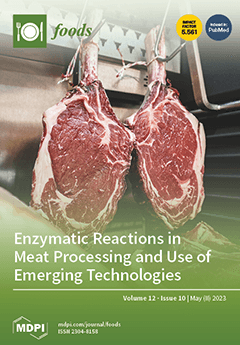In this study, the effects of pomegranate peel extract concentration (2.5–10%), drying temperature (160–190 °C), and feed flow rate (0.6–1 mL/s) on the properties of pomegranate juice powder enriched with pomegranate peel phenolic compounds and produced by spray drying were investigated. The moisture content, water activity (a
w), solubility, water absorption capacity (WAC), hygroscopicity, dissolution time, total phenolic content (TPC), Carr index (CI), Hausner ratio (HR), and brightness (L*) of the samples were evaluated, and the optimal powder production conditions were obtained using response surface methodology (RSM). The results showed that the optimal conditions were found to be the phenolic extract concentration of 10%, the drying temperature of 189.9 °C, and the feed flow rate of 0.63 mL/s, considering the minimization of the moisture content, a
w, hygroscopicity, dissolution time, CI, HR, and L*, as well as the maximization of solubility, WAC, and TPC. The effect of the phenolic extract concentration was very significant (
p < 0.01) on the WAC, hygroscopicity, dissolution time, TPC, CI, HR, and L* of the powder. Moreover, the effect of the drying temperature was very significant (
p < 0.01) on the a
w, hygroscopicity, dissolution time, CI, and HR of the powder and significant (
p < 0.05) on its moisture content. The effect of the feed flow rate was very significant (
p < 0.01) on the solubility, hygroscopicity, and dissolution time of the powder and significant (
p < 0.05) on its moisture content. Therefore, we found that the spray drying conditions, such as high temperature, did not negatively affect the content of phenolic compounds in pomegranate powder, and the physical properties of the resulting powder were acceptable. Thus, pomegranate powder enriched with phenolic compounds can be used as a food additive or as a dietary supplement for medicinal use.
Full article






